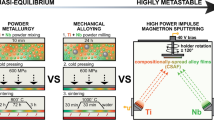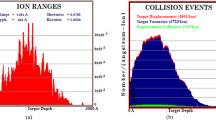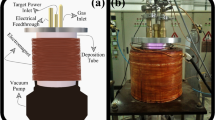Abstract
In order to explore the application of magnetron co-sputtering in fabricating the amorphous alloy, Zr-contained amorphous films were prepared by this technique and investigated by scanning electron microscope, energy disperse spectroscopy and X-ray diffraction. The results show that the co-sputtered films are in fully amorphous state or with amorphous-nanocrystalline structure. The XRD patterns of the Zr-Cu and Zr-Ni amorphous films exhibit a double-peak phenomenon. There is a shift of diffusive peak with changing the sputtering current which is possibly attributed to the change of Zr-Ni and Zr-Cu intermetallic like short range orders. In addition, Zr-Cu-Ni ternary co-sputtered films have a sharper peak at high angle. The sputtering yield of element during co-sputtering ranks as Cu>Ni>Zr, which can be ascribed to the contribution of melting and boiling temperature, atomic size and electrical conductivity of elements.
Similar content being viewed by others
References
Inoue A. Stabilization of Metallic Supercooled Liquid and Bulk Amorphous Alloys[J]. Acta Materialia, 2000, 48: 279–306
Johnson W L. Bulk Amorphous Metal-An Emerging Engineering Material[J]. JOM-Journal of the Minerals Metals & Materials Society, 2002, 54: 40–43
Schultz L, Eckert J. Glassy Metals III[M]. Berlin: Springer Varlag, 1994
Guo L Y, Geng S N, Pang J, et al. Structural Transformation and Property Improvement of Fe78Si9B13 Amorphous Ribbon by Pulsed Laser Processing[J]. Materials & Design, 2018, 160: 538–548
Jia C G, Pang J, Pan S P, et al. Tailoring the Corrosion Behavior of Fe-based Metallic Glasses through Inducing Nb-triggered Netlike Structure[J]. Corrosion Science, 2019, 147: 94–107
Wang X, Pang J, Guo L Y, et al. Thermal Analysis of Directional Pressure Annealed Fe78Si9B13 Amorphous Ribbons[J]. Thermochimica Acta, 2018, 661: 67–77
Ristič R, Stubičar M, Babić E. Correlation between Mechanical, Thermal and Electronic Properties in Zr-Ni, Cu Amorphous Alloys[J]. Philosophical Magazine, 2007, 87: 5 629–5 637
Basu J, Murty B S, Ranganathan S. Glass Forming Ability: Miedema Approach to (Zr, Ti, Hf)-(Cu, Ni) Binary and Ternary Alloys[J]. Journal of Alloys and Compounds, 2008, 465: 163–172
Chen C J, Huang J C, Chou H S, et al. On the Amorphous and Nanocrystalline Zr-Cu and Zr-Ti Co-sputtered Thin Films[J]. Journal of Alloys and Compounds, 2009, 483: 337–340
Jing Q, Xu Y, Zhang X Y, et al. Zr-Cu Amorphous Films Prepared by Magnetron Co-sputtering Deposition of Pure Zr and Cu[J]. Chinese Physics Letters, 2009, 26: 086 109–086 112
Marshall A F, Walmsley R G, Stevenson D A. Crystallization of an Amorphous Cu88Zr20 Alloy Prepared by Magnetron Sputter Deposition[J]. Materials Science and Engineering, 1984, 63: 215–227
Luo S, Yan B X, Shen J. Enhanced Photoelectric Property of Mo-C Codoped TiO2 Films Deposited by RF Magnetron Cosputtering[J]. Journal of Wuhan University of Technology-Mater. Sci. Ed., 2017, 32: 223–228
Li B J, Huang L J, Zhou M, et al. Preparation and Spectral Analysis of Gold Nanoparticles using Magnetron Sputtering and Thermal Annealing[J]. Journal of Wuhan University of Technology-Mater. Sci. Ed., 2014, 29: 651–655
Liu C Y, He F, Yan N N, et al. Influence of Deposition Pressure on Properties of ZnO: Al Films Fabricated by RF Magnetron Sputtering[J]. Journal of Wuhan University of Technology-Mater. Sci. Ed., 2016, 31: 1 235–1 239
Swann S. Magnetron Sputtering[J]. Physics in Technology, 1988, 19: 67
Zalnezhad E. Effect of Structural Evolution on Mechanical Properties of ZrO2 Coated Ti-6Al-7Nb-biomedical Application[J]. Applied Surface Science, 2016, 370: 32–39
Baradaran S, Zalnezhad E, Basirun W J, et al. Statistical Optimization and Fretting Fatigue Study of Zr/ZrO2 Nanotubular Array Coating on Ti-6Al-4V[J]. Surface and Coatings Technology 2014, 258: 979–990
Carcia P F, McLean R S, Reilly M H, et al. Transparent ZnO Thin-film Transistor Fabricated by RF Magnetron Sputtering[J]. Applied Physics Letters, 2003, 82: 1 117–1 119
Dudonis J, Brucas R, Miniotas A. Synthesis of Amorphous Zr-Cu Alloys by Magnetron Co-sputtering[J]. Thin Solid Films, 1996, 275: 164–167
Xu Y. Study on the Preparation and Crystallization Process of Zr-Cu Amorphous Alloy Thin Films[D]. Qinghuangdao: Yanshan University, 2005
Li Y, Guo Q, Kalb J A, et al. Matching Glass-Forming Ability with the Density of the Amorphous Phase[J]. Science, 2008, 322: 1 816–1 819
Chou H S, Huang J C, Lai Y H, et al. Amorphous and Nanocrystalline Sputtered Mg-Cu Thin Films[J]. Journal of Alloys and Compounds, 2009, 483: 341–345
Miyazaki H. Fabrication of YbAl 3 Film via Annealing Amorphous Yb-Al Film Deposited by RF Magnetron Sputtering[J]. Vacuum, 2008, 83: 416–418
Mattern N, Kühn U, Gebert A, et al. Microstructure and Thermal Behavior of Two-phase Amorphous Ni-Nb-Y Alloy[J]. Scripta Materialia, 2005, 53: 271–274
Antonian Z, Tu G H, Strom-Olsen J O. Crystallization Characteristics of Ni-Zr Metallic Glasses from Ni20Zr80 to Ni70Zr30[J]. Journal of Applied Physics, 1983, 54: 3 111–3 116
Sigmund P. Theory of Sputtering. I. Sputtering Yield of Amorphous and Polycrystalline Targets[J]. Physical Review, 1969, 184: 383–315
Dean J A. Lange’s Handbook of Chemistry[M]. New York: McGraw-Hill, Inc., 1999
Acknowledgement
The authors are grateful to Prof. Xiaolin Wang from University of Wollongong for his valuable discussions and assistance in the present paper.
Author information
Authors and Affiliations
Corresponding author
Additional information
Funded by Shandong Government Financial Supporting (No. L37002013098), Jinan Government Financial Supporting (Nos. JK201303067 and 301305033) and the National Natural Science Foundation of China (Nos. 51771103, 51471099 and 51571132)
Rights and permissions
About this article
Cite this article
Niu, Y., Guo, L., Zheng, Y. et al. Formation of Zr-contained Amorphous Alloy Films by Magnetron Co-sputtering. J. Wuhan Univ. Technol.-Mat. Sci. Edit. 34, 662–667 (2019). https://doi.org/10.1007/s11595-019-2101-3
Received:
Accepted:
Published:
Issue Date:
DOI: https://doi.org/10.1007/s11595-019-2101-3




